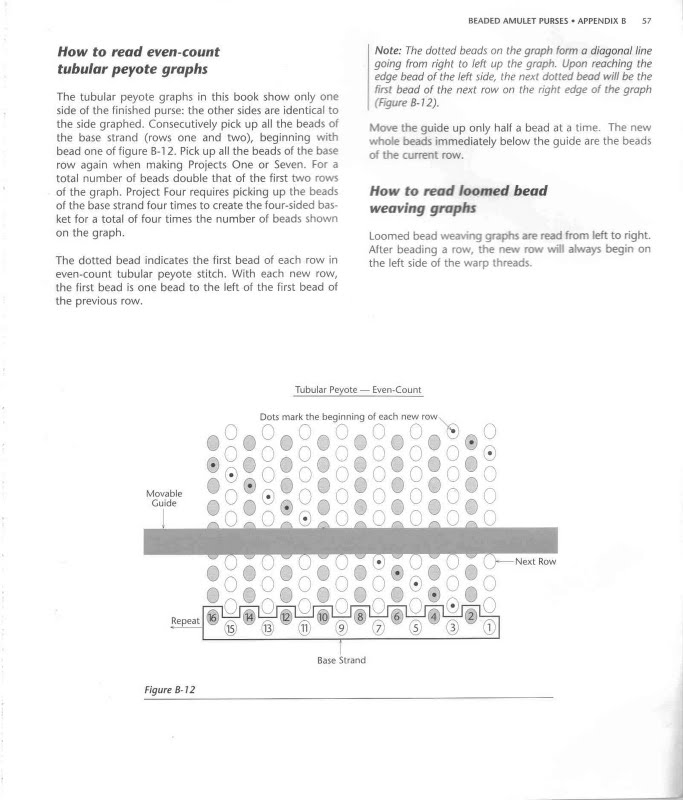57

BEADED AMULET PURSES • APPENDIX B 57
How to read even-count tubular peyote graphs
The tubular peyote graphs in this book show only one side of the finished purse: the other sides are identical to the side graphed. Consecutively pick up all the beads of the base strand (rows one and two), beginning with bead one of figurę B-l 2. Pick up all the beads of the base row again when making Projects One or Seven. For a total number of beads double that of the first two rows of the graph. Project Four requires picking up the beads of the base strand four times to create the four-sided bas-ket for a total of four times the number of beads shown on the graph.
The dotted bead indicates the first bead of each row in even-count tubular peyote stitch. With each new row, the first bead is one bead to the left of the first bead of the previous row.
Notę: The dotted beads on the graph form a diogonal linę going from right to left up the graph. Upon reaching the edge bead of the left side, the next dotted bead will be the first bead of the next row on the right edge of the graph (Rgure B-12).
Move the guide up only half a bead at a time. The new whole beads immediately below the guide are the beads of the current row.
How to read loomed bead weaving graphs
Loomed bead weaving graphs are read from left to right. After beading a row, the new row will ałways begin on the left side of the warp threads.
Tubular Peyote — Even-Count
Dots mark the beginning of each new row
*0.0*CU'0*0.0
JoroJoJoJoJoJor®
•®2oio20J0S0J0Jc

JoJoJSJSJSJStSJo
Next Row
Base Strand
Figurę B-12
Wyszukiwarka
Podobne podstrony:
BEADED AMULET PURSES • APPENDIX A 43Appendix ABeading Technigues Figurę A-la&b. The thread gaps
BEADED AMULET PURSES • APPENDIX A 45 BEADED AMULET PURSES • APPENDIX A 45 Figurę A-8 Figurę A-6a &am
BEADED AMULET PURSES • APPENDIX Et SSTo begin single-needle, right-angle weave Tie the base strand i
BEADED AMULET PURSES • PROIECT THREE 17 Sections to be read before beginning: • Tu
BEADED AMULET PURSES • PROJECT SIX 31 Sections to read before beginning: •
BEADED AMULET PURSES • PROJECT TWO 1J Sectlons to read before beginning: •
BEADED AMULET PURSES • BEADING SUPPLIES 5How To Use This Book After choosing a project, first read t
BEADED AMULET PURSES • PROJECT ONE 9 BEADED AMULET PURSES • PROJECT ONE 9 Sections to be read before
BEADED AMULET PURSES • PROJECT FOUR 21 Sections to bo read before beginning: • Tub
więcej podobnych podstron